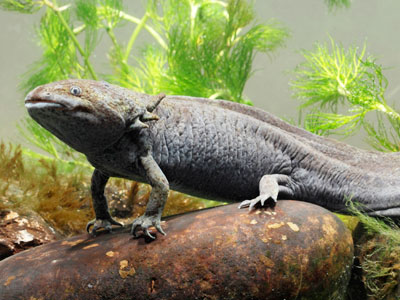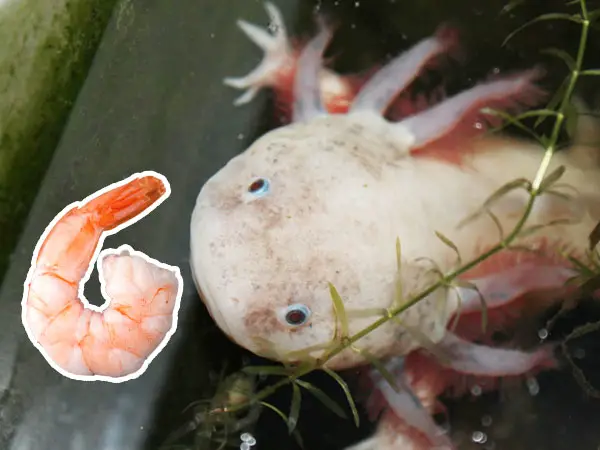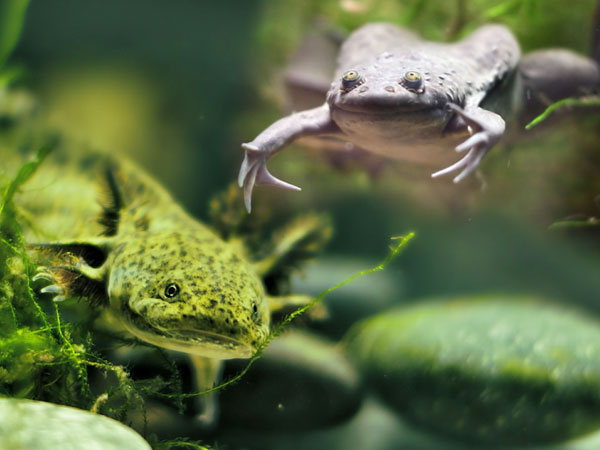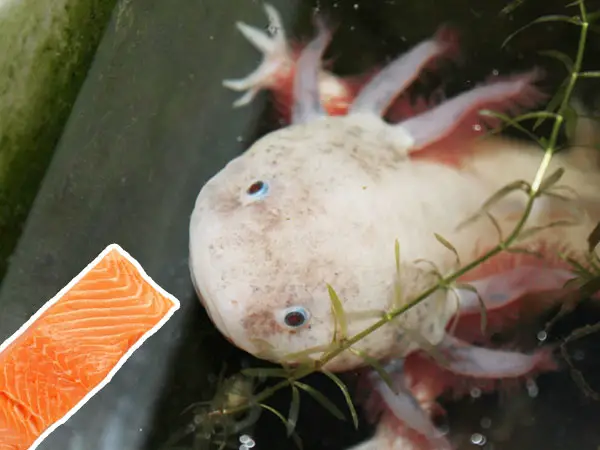
Contrary to what you seen on pictures posted on the internet, where axolotls are usually depicted as being cute and small, they can grow quite large, which is one of the primary reasons why they shouldn’t be kept in small aquariums.
Adult axolotls can reach sizes of up to 12 inches (30 cm), although the average axolotl size is around 9 inches (23 cm). Axolotls weigh between 60-225 grams (0.13-0.5 lb).
You may have seen some articles about axolotls weighing up to 8 pounds, which is a bit unrealistic, unless it’s an axolotl well over 12 inches, which is pretty rare.
If you’re worried about the size of your axolotl, in this article I’m going to delve into aspects related to the size and development of axolotls.
How to Tell if Your Axolotl is the Right Size?
The body mass of your axolotl depends on length and gender. For example, male axolotls may be slimmer compared to female ones.
One generally accepted rule is that their head should be approximately as wide as their body. Axolotls usually reach their full size at 18 months to 2 years. Their growth rate depends on many factors including water temperature and diet.
Another thing to consider is the differences between male and female axolotls. Female axolotls have rounded bodies compared to male axolotls because of the eggs they’re carrying.
A further difference is that the cloacal region of the male axolotl is much more swollen than that of the female. Also, male axolotls reach sexual maturity a bit sooner than females and usually display a more elongated body with a longer tail.
How to Measure Your Axolotl?
Since it’s not advisable to take your axolotl out of the water, measuring it can be a bit difficult, but there are ways to accomplish it without having to touch or to handle your axolotl at all.
The Ruler Method
You can measure your axolotl from the outside of the tank if your axie is sitting against the side of the tank either vertically or horizontally. This may not give you a 100% accurate measurement since both the glass and the water distort things, but it certainly beats taking your axolotl out of the water.
If you clean the ruler thoroughly, you can even make this measurement inside the water, but take care of sharp edges as your axie may bite at the ruler.
Even if you place the ruler into the water, your axolotl may not straighten out and you’ll still only get an approximate measurement.
The Fishing Line Method
I find that a much more accurate measurement is using a fish line to measure your axie in the water. With a fish line, you can measure your axolotl even if it’s not straightened out and get a more accurate measurement.
Plus, there’s no risk of the axie biting at the sharp edges of the ruler. They may bite your hand, though.
How to Weigh Your Axolotl?
If you want to weigh your axolotl, you can, but it involves getting them out of the tank and placing them into a plastic container filled with water.
You can place the water filled container on the scale, turn on the scale, place the axolotl in and see how much it weighs.
I only advise doing this if you’re going to have to take out your axolotl from the tank anyway (e.g. when transferring it to a larger tank).
Tips on Feeding & Caring for Axolotls
If you want your axolotls to stay healthy and develop normally, you’re going to have to feed them an adequate diet. But diet alone won’t cut it, you’ll also need to make sure they have great tank conditions.
Axolotls can become stressed and prone to diseases if their tank conditions are unstable. Temperatures that vary too much or that are outside of their temperature range can trigger stress and diseases.
Likewise, the water chemistry (toxin levels, water pH, water hardness, etc.) can all have an influence on the healthy development of your axolotl.
Keeping a close eye on the tank environment is essential to prevent diseases and encourage a healthy growth and development.
Performing regular water changes, removing uneaten food from the tank and being careful with where you source their food from are all things that are important in the process of caring for axolotls.
Axolotls thrive on a carnivorous diet that includes earthworms, blackworms, brine shrimp, small crustaceans, soft salmon pellets, and other nutritious meaty foods.
Making your own cultures or sourcing their food from organic gardens (earthworms) or fish-free waters (daphnia, brine shrimp, etc.) are best to ensure food safety.
Remember that while juvenile axolotls that are still under development require daily feedings, adult axolotls should be fed only 2-3 times per week.
Adult axolotls have a slow metabolism and don’t require daily feedings. It’s important to avoid overfeeding your axolotl because feeding them too often has health ramifications.
Too much food means that axolotls are producing more waste, which in turn leads to water chemistry issues.
On the other hand, axolotls can become constipated if fed too much food, which can be difficult to treat.
Sticking to 2-3 feedings per week and monitoring water conditions are the best ways to avoid issues down the road.
A healthy diet and a healthy tank environment will go a long way in sustaining the healthy development of your lotls.
Conclusion
Axolotls aren’t supposed to be very heavy but depending on their type, they can become very large and quite heavy.
On average, however, most axolotls will be around 9 inches and around 0.4 pounds, although some axolotl can definitely grow larger and heavier than this.
Now if your axolotl isn’t hitting these numbers it doesn’t mean there’s a problem. Depending on their age, gender, and type, there can be differences in size and weight.
You can measure your axolotl in various different ways, but instead of stressing about their size, I encourage you to practice good tank and water maintenance and make sure the food your feed your axolotls is safe and free of parasites and diseases.




